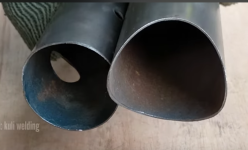I prefer 45T - liquidus is lower than 45, IIRC somewhat slightly north of 1200f. 45 is higher, 1350f or a tad higher. Generic off-the-shelf LFB is noticeably higher still at closer to 1600f (but much more affordable). But all fillers w/silver have gotten prohibitively expensive, so I'm extremely selective what I use it on.
I've been addicted to O/P since about '04. I was weened on O/A, but loading-transporting-unloading the dam heavy bottles (and a sharp rise in filling $) forced me to convert. I've been using BBQ bottles + oxygen concentrator ever since. MIG is usually my goto now - but I had to modify my gas preferences for that too - using straight cO2 now.
I've been addicted to O/P since about '04. I was weened on O/A, but loading-transporting-unloading the dam heavy bottles (and a sharp rise in filling $) forced me to convert. I've been using BBQ bottles + oxygen concentrator ever since. MIG is usually my goto now - but I had to modify my gas preferences for that too - using straight cO2 now.
Last edited:






